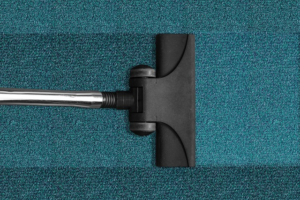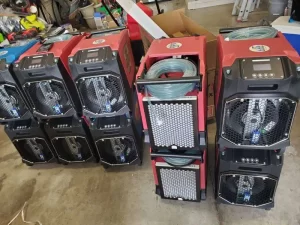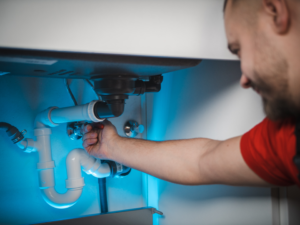Homeowners in Tennessee often have to deal with the consequences of water damage, which can be disastrous. Even worse is when that damage comes from sewer water swimming with dangerous bacteria, unpleasant odors, and serious health risks to the health of you and your family.
If you come home to a lake of raw sewage and solid waste, call a water damage restoration company immediately, follow their advice, and ensure you take all safety precautions before cleaning your carpets. To help get you started, let’s look at how to clean carpet after sewer backup.
Is Your Carpet Salvageable After Exposure To Sewage Backup?
Regarding water in your carpet, there are three safety categories: clear, grey, and black. Despite the name, these categories are based more on water quality than appearance, so don’t trust looks alone!
Here’s how you should handle each type:
- “Clear” water is usually safe because it comes from a clean source.
- “Grey” water comes from home appliances and may contain contaminants like food waste, dirty, soap, or detergent.
- “Black” water is the most dangerous, as it comes from outside your home, like flood or sewer water, and is thus highly contaminated with bacteria and waste. This contaminated water needs to be addressed quickly to prevent health hazards.
If your sewage backup has reached your carpet, it may be too late to save it. Clear and grey water is much easier to deal with on carpets, but if you are dealing with black water, it is best to turn to professional cleaners before getting started with sewage cleanup in the affected area.
How to Clean Your Carpet After Sewer Back up

While you need to bring in professional help to fix major damage from a sewer backup, here’s how to safely dive in on your own:
Ensure Proper Safety Precautions Before Cleaning Sewage Backup
Cleaning up raw sewage requires taking certain safety measures due to the serious health risks involved. Here are some safety precautions everyone should follow:
- Wear rubber boots to protect your feet from solid waste or other contaminants.
- Use a face mask to avoid breathing in harmful bacteria.
- Protect your hands and forearms with rubber gloves.
- Wear old clothes that you don’t mind getting dirty.
- Use clear plastic goggles to shield your eyes from splash damage.
Additionally, it’s important to have the tools to safely clean your carpet and belongings without causing further damage.
Gather Your Supplies
You will need safety gear, household disinfectant, a clean water source, a carpet knife, something to place the carpet on to dry, and a new carpet pad.
Even if the water appears clear, wear your rubber boots and gloves; other contaminants aren’t as visible, especially half-soaked into the carpet.
Turn Off Your Water
To prevent more water from soaking your carpet while you work, turn off your main valve. Prepare some clean water in a bucket or two first, so you can use it to clean the affected areas.
Assess Any Hazards
Make sure the water isn’t over any outlets in the wall before you step on the carpet. Electrified water is incredibly dangerous, so it is best practice to turn off your power. You may need to call your utility company for large-scale emergencies.
Clear the Room
Pull out any furniture or loose items in the affected area.
Wash them down with clean water, disinfect them, and set them outside or in a room without carpet to dry.
Shop Vac the Affected Area
You can use a wet vac to suck up a lot of the water both on and in the carpet. The more you can draw from your carpet, the better.
If the water is too deep to bring in a shop vac, use a raised surface like stairs or a waterproof stool you can clean later.
Try not to use an outlet in the contaminated area; use the cord length to reach another room. Don’t forget to remove your filter before using a shop vac for water and wet carpet.
Remove the Carpet
Use the carpet knife to cut away at the edges of your carpet and then slowly roll it as you walk back.
You can press on the carpet roll to help squeeze out excess water, making the carpet easier to carry. Be careful when working around tack strips around carpet edges— they’re sharp!
Dry the Carpet
Once the carpet is free and rolled, haul it somewhere and drape it over whatever you can to drain and dry. If the carpet is inside, open all your windows.
Set out fans, have the kids wear gloves, and sop up the water with towels, anything to get that carpet dry.
If you have that wet vac handy, use the hose attachments to get deep into the carpet.
Disinfect the Carpet
Once the carpet is dry, it’s time to treat it. Your best bet is a commercial product, but you can also use a solution of one cup of bleach to one gallon of water.
The problem with bleach is that it can be dangerous to inhale, it can harm your skin, and it can discolor your carpets.
Some stores like Nashville’s local Lowe’s and Home Depot offer carpet cleaning machines on a rental basis, and you can buy the product to fill the machine, as well.
You may need to clean the carpet more than once to get everything. Then, leave it to dry.
Discard the Carpet Pad and Clean
Water will most likely have seeped under your carpet and into the carpet pad. Carpet pads with water damage can’t be salvaged, but luckily new carpet pads are cheap. Pull the carpet pad up and toss it out before sweeping up any remaining debris.
With the carpet out of the way, start focusing on your walls and subflooring. Get everything dry and start disinfecting to remove health hazards like bacteria. You will likely find a lot of water damage.
Reinstall the Carpet with a New Carpet Pad
Once everything is clean and safe, you’ll need to install new carpet padding and carpet. Roll the carpet pad down and cut away any excess pieces.
Then, you can lay the carpet again. You may want to hire someone for carpet installation so you can be sure it’s installed properly.
How to Avoid Flooding and Water Damage From Sewer Backup
We all know the old adage: an ounce of prevention is worth a pound of cure. While sometimes a sewer backup is outside of your control, you can take steps to help keep your sewer functioning.
You can tell your sewer isn’t feeling great if your drains are slow, stinky, noisy, or chronically clogged. If you’re lucky, you can DIY the cleanup.
- Locate the first sink or toilet closest to where your drain line meets the city’s sewer. For toilets, shut off the water supply and flush out the water.
- Shake baking soda into the drain, close to half a cup, and chase it down with a quarter-cup of white vinegar. (Do you remember those classic science fair volcanoes? The foaming action will look pretty similar! The baking soda helps break down any gunk along the line, and the vinegar keeps it flowing.)
- Let it sit for 15 minutes, and then send hot water down the drain for a few minutes.
- Work your way through the drains in your house.
This is a fairly simple procedure that can help keep your sewer line clear and free of blockages. You can use enzyme-based cleaners as well, but too much commercial cleaner can damage your pipes. If there is an actual clog, you’ll want to call a plumber.
Other ways to keep your sewer happy include:
- Don’t pour grease down your drains;
- Don’t put trash or feminine supplies down the toilet;
- Use one-ply toilet paper;
- Limit how much food goes down the sink;
- Use a drain stopper to catch hair in the shower or bath;
- Don’t wash facial hairs down the drain after a shave;
- Keep cat litter away from drains, including in the basement;
- Have a plumber inspect your line annually; and
- Don’t plant trees near your sewer line.
Why You Should Hire a Professional Rather than Doing Everything Yourself

Sewage Water Poses Serious Risks To Your Health
A sewage backup is not only gross but also dangerous. Sewage carries millions of pesticides, fungi, protozoans, bacteria, and viruses that can make people sick.
In fact, the EPA estimates that more than 7 million people suffer from sewage-related illnesses each year. A sewer backup can also include toxins like hydrogen sulfide, E.Coli, and Salmonella.
Symptoms can include fever, cramping, vomiting, and severe gastroenteritis. The longer you’re exposed, the worse it can get.
If anyone has current serious health concerns or conditions like asthma or COPD, they should find somewhere else to stay until the harmful materials from the carpet and home by restoration services.
Professional Help Is Likely Required by Your Insurance Company
Most homeowners’ insurance policies have strict requirements for helping with large projects, including sewer backup on carpets. They likely require you to call a professional.
So, your main responsibility is mitigation efforts like turning off the water and finding a professional to come out and help.
The Right Tools for the Job
We have all the right tools to clear out the water quickly, drain and assess your carpets, and salvage what can be salvaged.
Water damage restoration crews even have extra equipment like special air scrubbers that create negative pressure to prevent airborne toxins from leaving the room. This helps protect our staff, your family, and your home by cleaning the air.
Expertise in Key To Maximizing Safety
This isn’t our first rodeo. We can tell at a glance whether you have clear, grey, or black water, and we can advise you on what items need to be replaced in the affected areas.
Water damage is our specialty, which takes the pressure off of you to try and guess if something is safe.
All-in-One Restoration Services For Carpets, Furniture, Floors, Walls, & Mold
In the event of any sort of water damage, everything needs a bit of attention. Water damage warps wood, causes mold growth, and even compromises the structural integrity of your home.
When you work with a restoration company, you get help for more than just your carpet. Professionals help with walls, wood, furniture, and more— a complete package, so you don’t have to take on the brunt of the stress. When you work with professionals, you know the job will be done safely and efficiently.
Our teams at TN Flood Kings are available 24/7 to address emergencies. If you’ve come home to a pond where your carpets should be, don’t give it time to settle; instead, call us.








